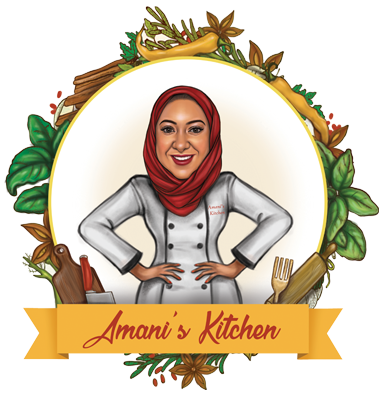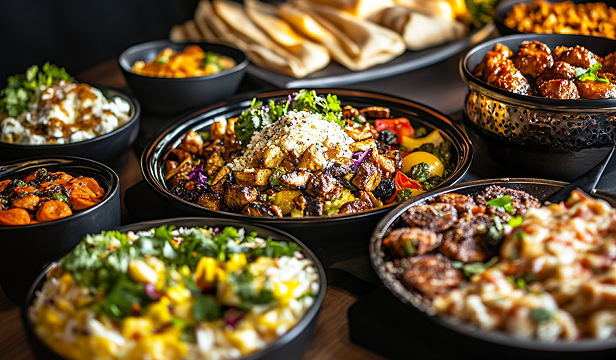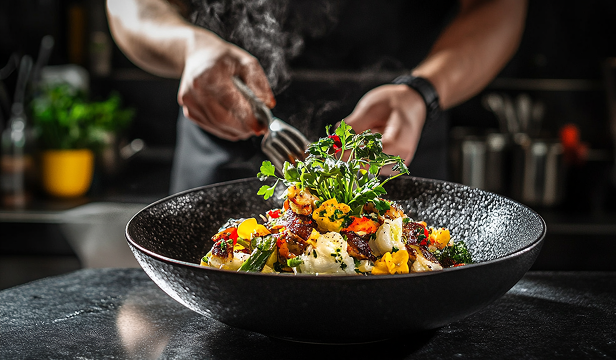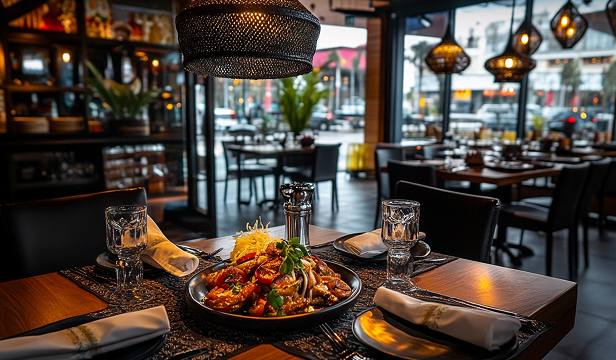Introduction Middle Eastern art is renowned for its intricate patterns, rich colours, and deep cultural…
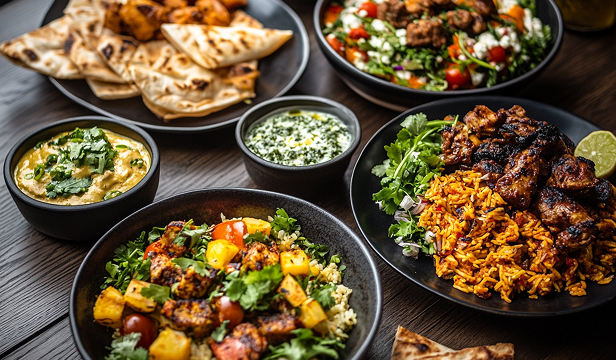
The Influence of Islamic Geometric Art in Middle Eastern Cuisine
Introduction
Islamic geometric art is a hallmark of Middle Eastern culture, adorning mosques, palaces, and manuscripts for centuries. Its intricate patterns, symmetry, and repetition serve not only as artistic expressions but also as a reflection of mathematical precision and spiritual significance. This artistic tradition extends beyond architecture and design into the culinary world, influencing food presentation, dish composition, and dining aesthetics in Middle Eastern cuisine.
The Principles of Islamic Geometric Art
Islamic geometric patterns are characterised by symmetry, repetition, and intricate interwoven shapes, often symbolising unity and infinity. These elements are mirrored in various aspects of Middle Eastern cuisine, from the way dishes are plated to the structural beauty of traditional foods.
- Symmetry and Balance: Just as Islamic art embraces balance through precise geometric arrangements, Middle Eastern dishes often exhibit symmetry in presentation, whether in the layering of ingredients or the arrangement of elements on a plate.
- Repetition and Patterns: Many dishes feature repetitive visual motifs, such as the arrangement of baklava, the lattice structure of kunafa, or the decorative cuts in bread.
- Mathematical Precision: Similar to the calculated proportions in Islamic patterns, Middle Eastern culinary arts rely on precise ingredient measurements and layering techniques to achieve perfect taste and aesthetics.
Islamic Geometric Art in Food Presentation
Middle Eastern cuisine often embraces the visual harmony found in geometric art through meticulous plating techniques and structured compositions:
- Plating Arrangements: Mezze platters, for example, are often arranged in circular or tessellated patterns, echoing the radial symmetry found in Islamic mosaics.
- Pastry Designs: Many traditional Middle Eastern pastries, such as baklava and ma’amoul, are cut into symmetrical shapes like diamonds or hexagons, reflecting geometric tessellations.
- Decorative Garnishing: Dishes are often garnished using finely chopped herbs, pomegranate seeds, or crushed nuts in symmetrical arrangements, mirroring intricate geometric patterns.
Structural Influence on Traditional Dishes
The structural and architectural qualities of Islamic geometric art are evident in the design and layering of various Middle Eastern dishes:
- Baklava: This iconic dessert is crafted in layered sheets with uniform geometric cuts, reflecting tessellation patterns seen in Islamic mosaics.
- Saffron Rice Mosaics: Persian and Arab cuisines feature rice dishes arranged in elaborate geometric formations using contrasting colours from saffron, barberries, and pistachios.
- Samoon Bread and Flatbreads: Traditional Middle Eastern breads often incorporate scored or stamped geometric designs before baking, reinforcing the deep connection between art and food.
The Cultural and Spiritual Symbolism in Food Art
Beyond aesthetics, the incorporation of geometric principles in Middle Eastern cuisine holds cultural and spiritual significance:
- Symbol of Unity and Perfection: The recurring motifs in both art and food symbolise the interconnectedness of life and the universe, aligning with the philosophical foundations of Islamic geometric design.
- Hospitality and Generosity: The structured yet elaborate presentation of Middle Eastern food reflects the region’s deep-rooted traditions of hospitality and communal dining.
- Historical Continuity: The continuation of these artistic influences in modern cuisine highlights the enduring legacy of Islamic art in everyday life.
Modern Applications and Fusion of Art in Contemporary Cuisine
As contemporary chefs explore innovative plating techniques, Islamic geometric art continues to inspire modern interpretations of Middle Eastern cuisine:
- Fine Dining Presentation: High-end Middle Eastern restaurants integrate geometric plating styles to create visually striking dishes that pay homage to tradition.
- Edible Art Installations: Some chefs use molecular gastronomy techniques to construct edible geometric sculptures, blending past and present artistic influences.
- Fusion Cuisine: Global chefs incorporate Islamic-inspired plating styles into non-Middle Eastern dishes, showcasing the universal appeal of geometric aesthetics.
Conclusion
The influence of Islamic geometric art in Middle Eastern cuisine highlights the intersection of culture, mathematics, and gastronomy. Through precise symmetry, repetition, and balance, traditional and modern Middle Eastern dishes embody the same artistic principles found in the region’s timeless architectural and decorative masterpieces. As the culinary world continues to evolve, this deep-rooted artistic heritage remains a guiding force in the visual and structural presentation of food, reinforcing the enduring connection between art and cuisine.
